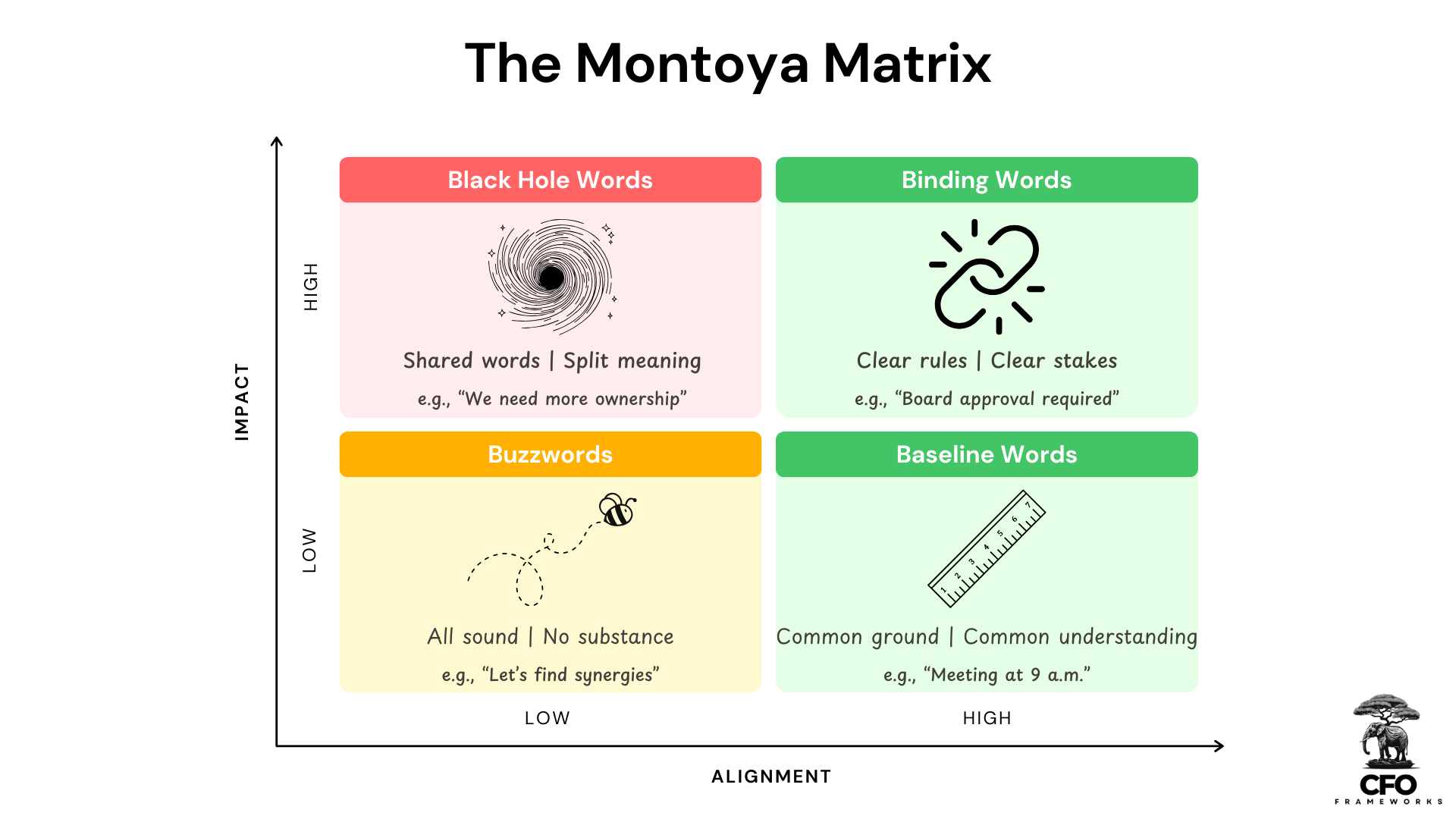The Montoya Matrix
A framework to ensure our words and actions speak the same language
On July 26, 1945, the Allied leaders issued the Potsdam Declaration to Japan—surrender unconditionally or face "prompt and utter destruction." When asked for Japan's response, Prime Minister Kantarō Suzuki told reporters it was one of mokusatsu.
The translation Washington received—"ignore with silent contempt"—triggered outrage. Within ten days, the atomic bomb fell on Hiroshima.
This may be the most tragic misunderstanding in history. The word mokusatsu, derived from "silence," has two distinct meanings. While the inflammatory translation was technically correct, there was a far less provocative interpretation:
"No comment."
While not universally accepted, this latter meaning is widely cited as Suzuki's intention—he was buying time while his government debated the surrender terms.
The translator could have noted this ambiguity. Suzuki could have been more precise. Instead, a single word's dual meaning helped trigger catastrophe.
While few modern miscommunications end in warfare, the business world faces its own costly battles over meaning. A single misaligned term in a strategic plan can waste millions in resources, derail critical projects, or destroy valuable partnerships. Just ask the CFO who approved what they thought was an 'incremental' investment in a new product line, only to discover that while corporate defined 'incremental' as net-new revenue to the company, the division meant revenue that was incremental to their P&L - even if it cannibalized other divisions. Or consider the transformation project where 'run-rate savings' meant something entirely different to Finance (cost reductions achieved in-year) versus Operations (theoretical savings once all changes were fully implemented), leading to a painful earnings miss and some difficult board conversations.
The challenge isn't just about precision - it's about detecting misalignment before it creates chaos.
What makes these misalignments particularly dangerous is their invisibility. When we encounter completely foreign terms, we naturally seek clarification. But the deceptively familiar phrases—the ones we think we understand—create the deepest chasms of miscommunication. Like a fault line hidden beneath seemingly solid ground, these semantic gaps can remain undetected until they rupture.
These chasms are everywhere in business language, hiding in plain sight. Take a typical strategic planning meeting where everyone nods along to the need for more "innovation." To the CTO, this means investing millions in quantum computing research. To the Head of Product, it means A/B testing different button colors. To the CFO, it means finding clever ways to reduce costs. Three executives leave the room, each confident they're aligned, each heading in radically different directions.
These semantic gaps—what Molly Graham aptly calls "black hole words"—are treacherous because they create an illusion of alignment while masking fundamental disagreements. Like their celestial namesakes, they have massive hidden gravity, pulling resources and effort into an invisible void. But not all misaligned terms are equally dangerous.
Even attempts at precision can fall prey to misalignment. An HBR survey of 1,700 professionals revealed that common probability terms carry wildly different meanings: "highly likely" meant anything from a 50% to 90% chance of success. When millions of dollars hang on such assessments, this variance isn't just semantic—it's existential.
Probability terms are just the beginning. Words like "strategic," "agile," and "customer-centric" have become so stretched and distorted that they've lost any shared meaning. Yet executives continue to build plans around them, like architects trying to measure with elastic rulers.
This raises a crucial question: why do some ambiguous terms create mere confusion while others trigger catastrophe?
Like Inigo Montoya's famous observation about misused words, we need a way to identify terms that don't mean what we think they mean. Let's call it the Montoya Matrix—a tool for mapping language along two critical dimensions:
Alignment: Do people share the same definition?
Impact: How much damage can confusion cause?
When we plot terms along these axes, four distinct quadrants of business language emerge:
The Montoya Matrix helps us identify and manage these quadrants, each with its own characteristics and risks:
Black Hole Words are the most dangerous—terms like "innovation" or "strategy" can derail entire projects when different interpretations collide. Their gravity pulls in multiple meanings while creating an illusion of alignment. These words appear precise enough to build plans but contain hidden chasms of misunderstanding that only become visible when it's too late.
Binding Words, by contrast, create clarity through precise, enforced definitions. When someone says "board approval" or "EBITDA margin," there's little room for interpretation. These terms often have formal definitions or legal consequences—like "material disclosure" in SEC filings.
Buzzwords like "synergy" or "thought leadership" create noise but rarely affect outcomes. Everyone knows these terms are more decoration than substance—no one has ever lost sleep over conflicting definitions of "paradigm shift." Their vagueness is so obvious that they function more as corporate wallpaper than decision-making tools.
Baseline Words provide the foundation for basic coordination—terms like "fiscal year" or "signed contract" that mean exactly what everyone thinks they mean. These terms rarely cause problems because they're either backed by clear external standards or so fundamental that misalignment would make basic business impossible.
Understanding these quadrants reveals why some organizations thrive while others stumble over their words. In healthy environments, teams actively convert Black Hole Words into Binding Words. In toxic ones, people learn to hide behind comfortable vagaries—using ambiguity as a shield.
Like any diagnostic tool, the Montoya Matrix isn't just for identification—it's for action. Here's how to use it:
Identify Your Black Holes: Audit your organization's most important documents—strategic plans, OKRs, and project charters. Circle terms that could mean different things to different stakeholders. Pay special attention to words that appear frequently in high-stakes decisions.
Convert to Binding Words: For high-impact terms, create explicit definitions with measurable components. If "customer satisfaction" matters to your business, define exactly how it will be measured and tracked. Make these definitions visible and reference them consistently.
Eliminate Buzzwords: Replace vague terms with specific, measurable language. "Drive innovation" becomes "launch new products in specific markets." "Improve efficiency" becomes "reduce specific process times by defined percentages."
Build on Baseline: Ground complex concepts in commonly understood terms. Rather than asking "Are we aligned on the strategy?" (a Black Hole invitation), ask "What specific metrics will show we're succeeding?" Rather than "significant opportunity," define the actual revenue or cost numbers you're targeting.
The mokusatsu incident shows us that even small linguistic gaps can have massive consequences. While modern business stakes may not reach the level of atomic warfare, they're still profound—failed products, broken partnerships, destroyed careers. Each time we let a Black Hole Word pass unchallenged or hide behind comfortable buzzwords, we risk our own small-scale catastrophe.
The solution isn't perfect precision—it's purposeful clarity. Know which words matter most, define them explicitly, and build the courage to ask, "What exactly do you mean by that?"
The cost of clarity is the momentary discomfort of asking hard questions. The cost of ambiguity is the lasting pain of acting on wrong answers.





